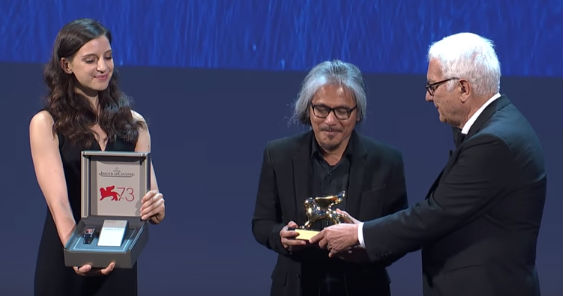by Rome Jorge
‘Ang Babaeng Humayo’ (The Woman Who Left) wins the Golden Lion award at the 2016 Venice International Film Festival
Once again, Filipino film director Lav Diaz garners global renown by winning the Leone d’Oro for having crafted the best film at this year’s Mostra Internazionale d’Arte Cinematografica della Biennale di Venezia—the world’s oldest film festival and, along with the Cannes and the Berlin film festivals, is one of the world’s most prestigious—for his film “Ang Babaeng Humayo” (The Woman Who Left).
Written by Diaz as well, “Ang Babaeng Humayo” takes inspiration from Leo Tolstoy’s 1872 short story “God Sees the Truth, But Waits” about a merchant who is wrongly jailed for murder and then forgives the true murderer upon his release after 26 years.
“Ang Babaeng Humayo” takes off where Tolstoy’s story ends with the “woman” Horacia Somorostro, played by Charo Santos-Concio, finding no peace even after being released after 30 years and hearing fellow inmate and best friend Petra, played by Sharmaine Centenero-Buencomino, confesses to framing her in a conspiracy with ex-boyfriend Rodrigo, played by Michael de Mesa. She plots her revenge against Rodrigo, now underworld boss, by assuming a new identity and living a double life even as she cares for the likes of mentally challenged street sleeper Mameng, played by Jean Judith Javier, and abused epileptic transsexual street-walker Hollanda, played by John Lloyd Cruz.
“Ang Babaeng Humayo” was shot by Diaz himself in stark black and white.
Film critic Clarence Tsui of The Hollywood Reporter remarked, “’The Woman Who Left’ is a taut exercise in which every shot burns with condensed emotions and human empathy, whether in the riveting depiction of the characters’ quotidian existence throughout, or the heartbreaking shots of Manila’s gloomy cityscape which makes up the final minutes of the film.”
Film critic Guy Lodge of Variety Magazine notes, “Working once more in rich but unromantic black and white, Diaz’s cinematography is the film’s other most constant reward. Alternating between deep chiaroscuro strokes in the cobwebbed sites of its heroine’s past to more candid, semi-blurred shooting as she gradually loses her grip on proceedings, no frame here seems carelessly assembled or bereft of perspective. Serving as his own cameraman appears to concentrate the director’s worldview.”
Diaz had previously won the Orizzonti Grand Prize at the Venice International Film Festival for his 2008 film “Melancholia,” the Un Certain Regard at the Cannes Film Festival for his 2013 film “Norte, Hangganan ng Kasaysayan” (Norte, the End of History), and the Silver Bear Alfred Bauer Prize at the Berlin International Film Festival for his 2016 film “Hele sa Hiwagang Hapis” (A Lullaby to the Sorrowful Mystery).








